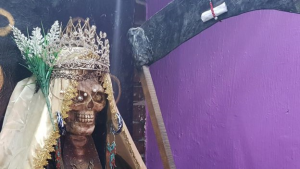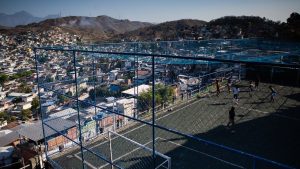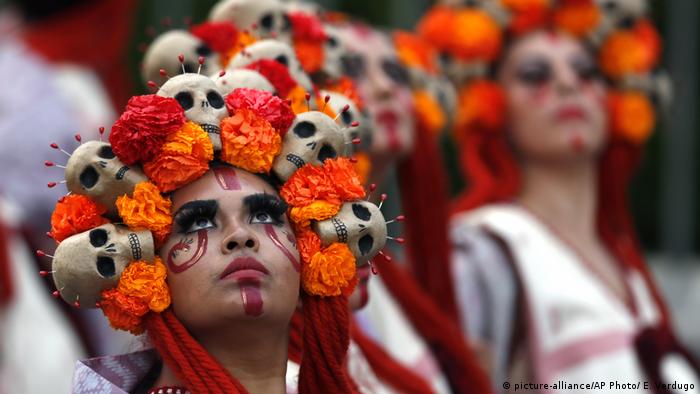BBC News Duncan Tucker Santa Muerte: The rise of Mexico’s death ‘saint’
Catholic News Agency Mary Rezac Have you heard of Saint Death? Don’t pray to her
I originally found the article “Santa Muerte: The rise of Mexico’s death ‘saint’” by BBC News and I found the article so intriguing that I decided to try and understand more background information on her. This lead me to the article “Have you heard of Saint Death? Don’t pray to her,” which is published by a Catholic Website called Catholic News Agency (CNA). Therefore, I will be summarizing first the article by BBC News and then what background information I gained from CNA.
In “Santa Muerte: The rise of Mexico’s death ‘saint’” it explains who this ‘saint’ is. Santa Muerte is a ‘saint’ who is non-judgmental that many single mothers, members of the LGBT, and gang members pray to her. Santa Muerte serves as a ‘saint’ for the people who are treated as outcasts. The people who follow this religion feel it is deeply misunderstood and it is not a satanic mass. Worshipping Santa Muerte has surged in popularity and has about 10 to 12 million followers world-wide. Many of Santa Muerte’s followers believe she is the reincarnation of the Aztec goddess Mictecacihuatl, who presided over a festival of death every August. This article explains that members of this religion have decided to make Day of the Dead her feast day, which is angering the Catholic church. The Vatican has denounced Santa Muerte and repeatedly says this every year around the Day of the Dead to make clear she is not a part of the Catholic church nor will she ever be.
This leads to the article by CNA which provides more of an explanation of why it is growing in popularity. One reason they say Santa Muerte is growing in popularity is due to the drug wars. This article says that gang members do not feel comfortable praying to God for protection against the police and instead will pray to Santa Muerte and offer something in exchange. Another reason the drug wars have increased the popularity of Santa Muerte is because the victims of the drug wars find a ‘saint’ of death very appealing.
These two articles authors had very different purposes in their writing. The author from BBC wanted to briefly explain who Santa Muerte is and what her worshippers are like, while the author for the CNA’s intentions is to explain to readers why not to pray to Santa Muerte. Of course, the author’s viewpoints are going to be different because their readers are different. BBC news is for everyone to read while the CNA’s target audience is for Catholics. These two articles about the same topic prove how the target audience can affect the author’s argument.
Santa Muerte portrays the Mexican people as people who are deeply religious. While she is not tied to the Catholic church like most saints her presence still shows Mexicans as deeply spiritual and wanting a religious figure.
One of the reason’s I chose Santa Muerte is because of the class discussions the class has had together. One of the things we have talked about in class is the local saints that exist in Latin America and the effect they can have on a community. However, unlike the saints talked about in class the Catholic church has renounced her and has made it clear she will never be a saint to them. Santa Muerte is almost a ‘saint’ for the outcasts and can make them feel accepted for who they are, but she is also serving as an excuse for some gang members. Santa Muerte is very helpful for the people who consider themselves outcasts. She has helped their identity greatly. The gang members feel since Santa Muerte is accepting the gang members do not have to improve who they are. Another heavily talked about topic in class is gang violence and cartels. It is interesting how the rise of gangs has indirectly increased the popularity of Santa Muerte.







 The article begins by giving a description of the issue. It is commonly accepted that global warming is the result of greenhouse gases such as Carbon Dioxide. Carbon Dioxide tends to be emitted in large amounts through the burning of fossil fuels and other human activities. The authors of the article argue that as a global community we have been approaching the situation incorrectly. Instead of trying to eliminate global warming by preventing deforestation, the authors suggest that we should turn our attention to the concept of reforestation. This idea of second-growth forests (“SFs” in the article) was the driving theme present in the research article because it appears that these forests contain a lot of potential for carbon sequestration. So what exactly is a second-growth forest? Second-growth forests are the regrowth of organisms and populations in a specific land environment after a traumatic destruction of the land (ex: wildfire,
The article begins by giving a description of the issue. It is commonly accepted that global warming is the result of greenhouse gases such as Carbon Dioxide. Carbon Dioxide tends to be emitted in large amounts through the burning of fossil fuels and other human activities. The authors of the article argue that as a global community we have been approaching the situation incorrectly. Instead of trying to eliminate global warming by preventing deforestation, the authors suggest that we should turn our attention to the concept of reforestation. This idea of second-growth forests (“SFs” in the article) was the driving theme present in the research article because it appears that these forests contain a lot of potential for carbon sequestration. So what exactly is a second-growth forest? Second-growth forests are the regrowth of organisms and populations in a specific land environment after a traumatic destruction of the land (ex: wildfire,  I think this article portrays Latin America in a positive light. For four Latin American countries to be leading the carbon sequestration attempt out of ten countries total is very impressive. This article shows that Latin America is very concerned with how Carbon Dioxide is affecting the planet that we live on. I think by running these tests and experiments and finding tactics that work, Latin American countries are taking responsibility, or at the very least acknowledging that human activity on earth can be detrimental to our planet. I feel as though these Latin American countries are leading by example in hopes of inspiring the rest of the global community to follow in their footsteps in helping to prevent global warming. This article is less about the cultural identity in Latin America and more about how Latin America interacts in the world. I think that because Latin America is known for its tropical regions and is abundant in its flora and fauna it feels the need to advocate and be proactive about these issues.
I think this article portrays Latin America in a positive light. For four Latin American countries to be leading the carbon sequestration attempt out of ten countries total is very impressive. This article shows that Latin America is very concerned with how Carbon Dioxide is affecting the planet that we live on. I think by running these tests and experiments and finding tactics that work, Latin American countries are taking responsibility, or at the very least acknowledging that human activity on earth can be detrimental to our planet. I feel as though these Latin American countries are leading by example in hopes of inspiring the rest of the global community to follow in their footsteps in helping to prevent global warming. This article is less about the cultural identity in Latin America and more about how Latin America interacts in the world. I think that because Latin America is known for its tropical regions and is abundant in its flora and fauna it feels the need to advocate and be proactive about these issues.


